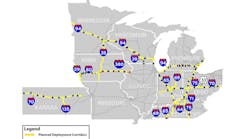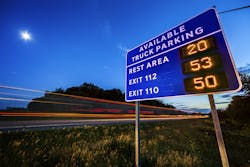Real-time truck parking data aims to strengthen Midwest freight corridors
CINCINNATI. Finding truck parking will soon be easier in eight mid-American states.
Like the highway signs that alert drivers how much time it will take them to get to certain exits or interchanges, the Mid America Association of State Transportation Officials (MAASTO) is about to launch a $28.6 million program to help truckers find parking.
The Truck Parking Information and Management System (TPIMS) is on schedule to debut along nine high-volume freight corridors by the summer of 2019 after a soft launch this fall, according to Davonna Moore, the MAASTO TPIMS project manager and assistant bureau chief of transportation planning for the Kansas DOT.
"Back in 2015, the MAASTO states got together to figure out how we can help freight and truckers," Moore told Fleet Owner. "We knew there was a legislative initiative about ELDs and Hours of Service, we knew there was a problem with truck parking, we knew there was also a safety issue after Jason's Law. So we asked, 'What can we do?'"
Kansas, Iowa, Minnesota, Wisconsin, Michigan, Indiana, Ohio and Kentucky teamed up to implement this regional truck parking system, which is currently under construction in all eight states. "So if you drive around in some of these states, you'll probably start to see these signs go up," Moore said.
When completed, TPIMS will cover more than 150 monitored parking sites on the high-volume highways for freight: I-35, I-39, I-64, I-65, I-70, I-71, I-75, I-80, I-94, I-135, and U.S. Route 33 in Ohio.
The information isn't limited to highway signs. It will also be made available, as open source, to smartphone apps, telematics companies, travel information websites and more. Moore was at the National Private Truck Council's annual convention here in Cincinnati to spread the word about TPIMS and how fleets and telematics companies can get and disseminate the information.
This free public data feed is already being tested in Wisconsin. The eight participating states created a standard data feed for public and private truck sites along those freight routes. The data elements and formatting by MAASTO is intended to set a standard for future projects across the country. That information, Moore said, would be updated every five minutes from each parking location.
"So anyone with a platform can take this data in – for free – and apply it to whatever they're doing," Moore said. She envisions telematics companies adding this information to trucking GPS programs. So if a driver gets an alert about traffic slowdowns due to construction or accidents, they would also see where the nearest available truck parking is. This would allow drivers and fleets to plan routes and comply with Hours of Service rules.
"That's what everyone here has been excited about – that we're adding a piece of the puzzle to that," Moore said of the reaction of other fleets and technology companies she's met with at NPTC 2018. "And what's different about this is there are a lot of applications out there that use crowd-sourcing to help truckers find parking, this is actually based off technology. This is a $30 million project and each state has implemented some sort of technology that will count trucks going in or out of the facilities or will actually do a space-by-space count using technology with cameras or magnetometers in the ground."
One of the most important things about TPIMS, she said, is that it is a truly regional system. And that's why she thinks it will be successful. "We wanted to have one single system. We didn't want truckers or anybody else to have eight different systems to deal with," Moore said.
The $28.6 million project is mostly being funded through a $25 million federal TIGER grant in 2015 with the rest coming from state funding. MAASTO projects the project to generate more than $400 million in benefits, according to project documents. Those benefits come from fewer non-routine repairs along highway shoulders and ramps due to unauthorized parking. MAASTO also says it will make the movement of freight through the Midwest more efficient, lead to less fuel consumption and reduced emissions because drivers will spend less time looking for parking.
"If something like this was implemented nationwide, it could save $4.4 billion for the economy," Moore said. That is how much commercial truck drivers' search for safe, convenient parking costs the country annually, according to MAASTO. It also increases CO2 emissions by 3.3 million tons.
The Florida DOT is also implementing a similar project but it's not a regional project. And Moore said she has been talking with the I-95 Corridor Coalition, which has been looking for a way to do something similar.






